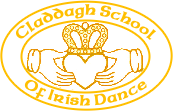Irish Dance History from the Claddagh School of Irish Dance
Perhaps the history should begin with the Celtic peoples, also known as the Gaels. These peoples spread over Western Europe including France, Northern Spain, and the British Isles, spreading to Ireland in the 3rd century BC. Saint Patrick introduced Christianity into the country in the 5th century AD. Although little is known about the dancing in this period, the artwork survived and has influenced Irish dance costumes. Many of the designs on current day costumes are based upon illustrated manuscripts of the Bible, the most famous of which is the Book of Kells.
The Viking raids during the 10th century destroyed most of the books in existence; however, it is certain that music and dance played an important part in the Gaelic culture. The Traditional Irish culture continued through the Middle Ages when dances were once again recorded. It is not clear whose dances influenced whom among the Irish, English and French, but it is characteristic that the Irish dances had a faster tempo.
Irish dance and culture continued to evolve and in the mid 1700's, Dance Masters began the tradition of traveling village to village teaching the various dance steps they had created. It is from these teachers that the current day Irish set and ceili dances originated.
The four basic types of modern day Irish music and associated dances are the jig, reel, hornpipe and the set dances. The jig, which was referenced in ancient Ireland, has several variations including the single jig and slip jig. The slip jig is the most graceful of the Irish dances and features light hopping, sliding and skipping. Only women dance the slip jig. Jig music is 6/8 time; slip jigs are in 9/8 time.
The reel originated around 1750 in Scotland and the Irish dance masters brought it to its full development. Women and men both dance the reel. Women perform it as a light, rapid soft shoe dance that often includes leaping and always demands a high level of energy. Men usually dance the reel in hard shoes. Reel music is in 4/4 time and is usually danced to a fast tempo.The music accents the first beat.
The hornpipe also began in the mid 1700's and evolved from English stage acts. It was originally danced exclusively by men, but now, both men and women perform this dance.The hornpipe is in 4/4 time and is similar to a slow reel but has accents on the first and third beat.
Set dances are performed by individual dancers to a specific tune with each set dance having its own tune. Some of the tunes are more than 250 years old. Ceili (pronounced Kay-Le) dances are similar to the set dances, however these are performed by a group of dances. A "ceili" is Gaelic for a gathering for music and dance.
The Claddagh School of Irish Dance is owned and operated by Mary Mulvagh Quinn. Mary is a native of Springfield, MA. She began taking Irish dance lessons at the age of 5 at the John Boyle O'Reilly Club in Springfield. Her feet have not stopped since then.
She competed in Irish Dance Competitions throughout New England, New York, Canada and Ireland for many years and has been teaching Irish Step Dancing for over 20 years.
Mary's parents were immigrants from Galway, Ireland where the Claddagh Village is located. In honor of all of the love and support her Mother and Father gave to her during her younger dancing years, Mary has named the school in their memory.
